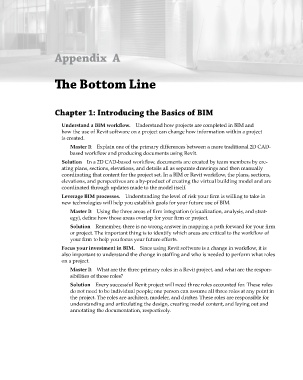Page 903 - Divyank Tyagi
P. 903
Appendix A
The Bottom Line
Chapter 1: Introducing the Basics of BIM
Understand a BIM workflow. Understand how projects are completed in BIM and
how the use of Revit software on a project can change how information within a project
is created.
Master It Explain one of the primary differences between a more traditional 2D CAD-
based workflow and producing documents using Revit.
Solution In a 2D CAD-based workflow, documents are created by team members by cre-
ating plans, sections, elevations, and details all as separate drawings and then manually
coordinating that content for the project set. In a BIM or Revit workflow, the plans, sections,
elevations, and perspectives are a by-product of creating the virtual building model and are
coordinated through updates made to the model itself.
Leverage BIM processes. Understanding the level of risk your firm is willing to take in
new technologies will help you establish goals for your future use of BIM.
Master It Using the three areas of firm integration (visualization, analysis, and strat-
egy), define how those areas overlap for your firm or project.
Solution Remember, there is no wrong answer in mapping a path forward for your firm
or project. The important thing is to identify which areas are critical to the workflow of
your firm to help you focus your future efforts.
Focus your investment in BIM. Since using Revit software is a change in workflow, it is
also important to understand the change in staffing and who is needed to perform what roles
on a project.
Master It What are the three primary roles in a Revit project, and what are the respon-
sibilities of those roles?
Solution Every successful Revit project will need three roles accounted for. These roles
do not need to be individual people; one person can assume all three roles at any point in
the project. The roles are architect, modeler, and drafter. These roles are responsible for
understanding and articulating the design, creating model content, and laying out and
annotating the documentation, respectively.
bapp01.indd 869 5/3/2014 12:11:31 PM

